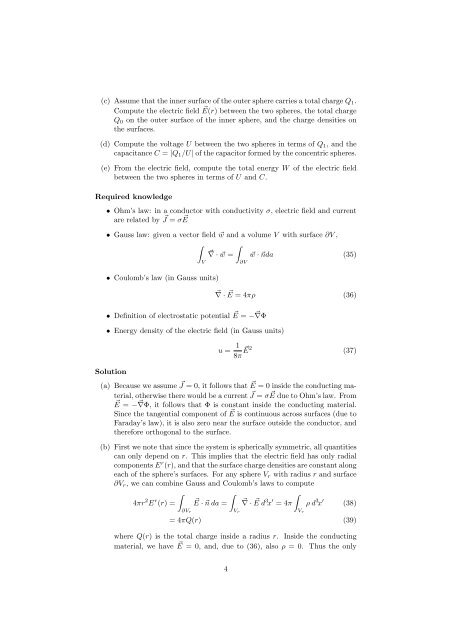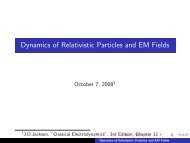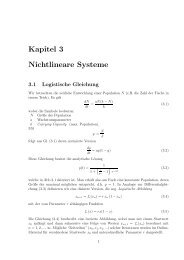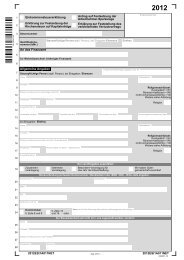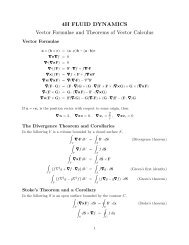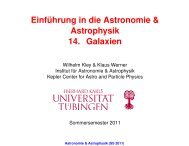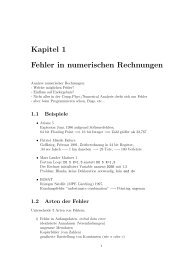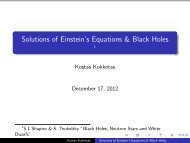Field Theory exam II â Solutions
Field Theory exam II â Solutions
Field Theory exam II â Solutions
You also want an ePaper? Increase the reach of your titles
YUMPU automatically turns print PDFs into web optimized ePapers that Google loves.
(c) Assume that the inner surface of the outer sphere carries a total charge Q 1 .<br />
Compute the electric field ⃗ E(r) between the two spheres, the total charge<br />
Q 0 on the outer surface of the inner sphere, and the charge densities on<br />
the surfaces.<br />
(d) Compute the voltage U between the two spheres in terms of Q 1 , and the<br />
capacitance C = |Q 1 /U| of the capacitor formed by the concentric spheres.<br />
(e) From the electric field, compute the total energy W of the electric field<br />
between the two spheres in terms of U and C.<br />
Required knowledge<br />
• Ohm’s law: in a conductor with conductivity σ, electric field and current<br />
are related by ⃗ J = σ ⃗ E<br />
• Gauss law: given a vector field ⃗w and a volume V with surface ∂V ,<br />
∫ ∫<br />
⃗∇ · ⃗w = ⃗w · ⃗nda (35)<br />
• Coulomb’s law (in Gauss units)<br />
V<br />
∂V<br />
⃗∇ · ⃗E = 4πρ (36)<br />
• Definition of electrostatic potential ⃗ E = − ⃗ ∇Φ<br />
• Energy density of the electric field (in Gauss units)<br />
Solution<br />
u = 1<br />
8π ⃗ E 2 (37)<br />
(a) Because we assume ⃗ J = 0, it follows that ⃗ E = 0 inside the conducting material,<br />
otherwise there would be a current ⃗ J = σ ⃗ E due to Ohm’s law. From<br />
⃗E = − ⃗ ∇Φ, it follows that Φ is constant inside the conducting material.<br />
Since the tangential component of ⃗ E is continuous across surfaces (due to<br />
Faraday’s law), it is also zero near the surface outside the conductor, and<br />
therefore orthogonal to the surface.<br />
(b) First we note that since the system is spherically symmetric, all quantities<br />
can only depend on r. This implies that the electric field has only radial<br />
components E r (r), and that the surface charge densities are constant along<br />
each of the sphere’s surfaces. For any sphere V r with radius r and surface<br />
∂V r , we can combine Gauss and Coulomb’s laws to compute<br />
∫<br />
∫<br />
4πr 2 E r (r) = E ⃗ · ⃗n da = ∇ ⃗ · E ⃗ d<br />
∫∂V 3 x ′ = 4π ρ d 3 x ′ (38)<br />
r V r V r<br />
= 4πQ(r) (39)<br />
where Q(r) is the total charge inside a radius r. Inside the conducting<br />
material, we have ⃗ E = 0, and, due to (36), also ρ = 0. Thus the only<br />
4


